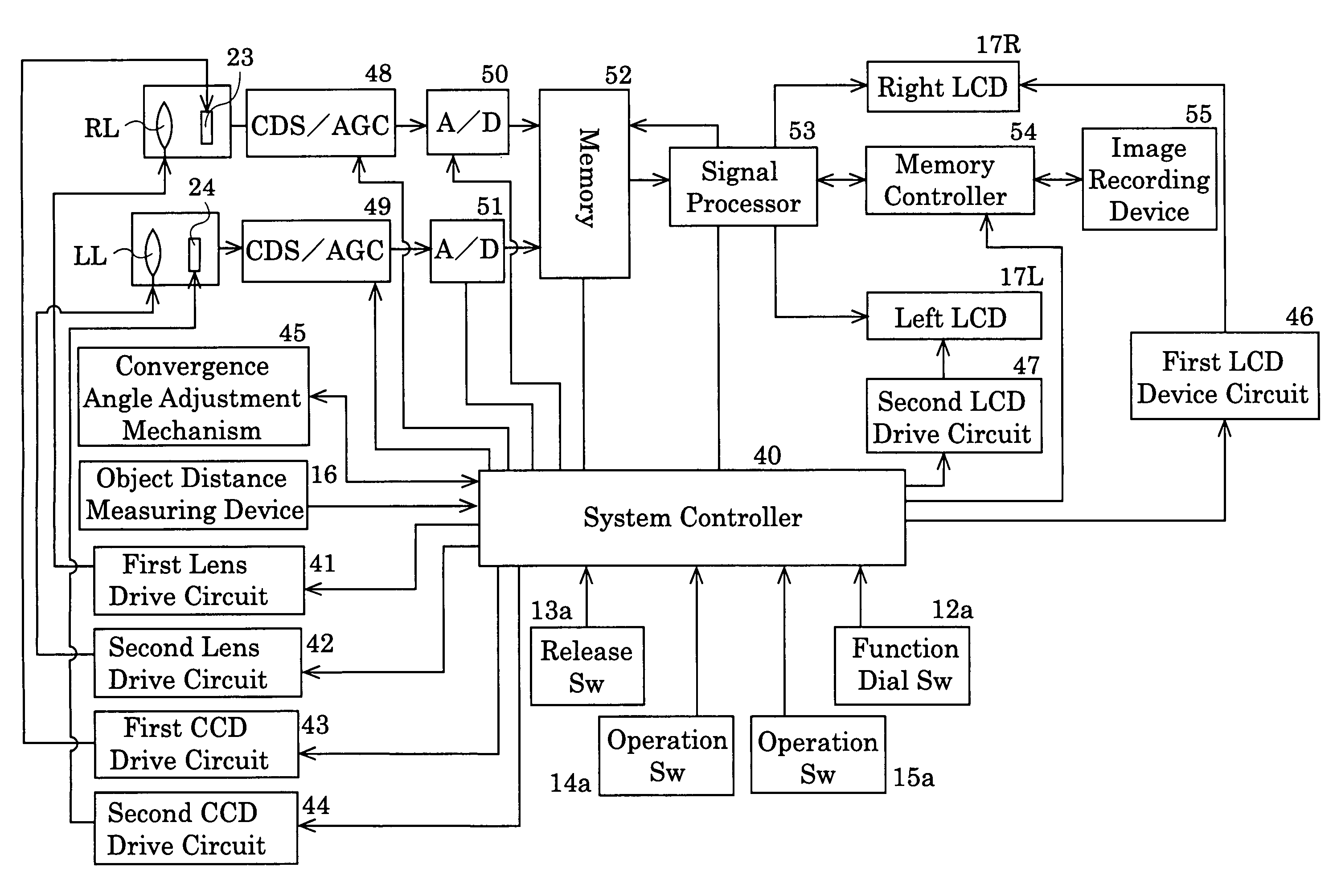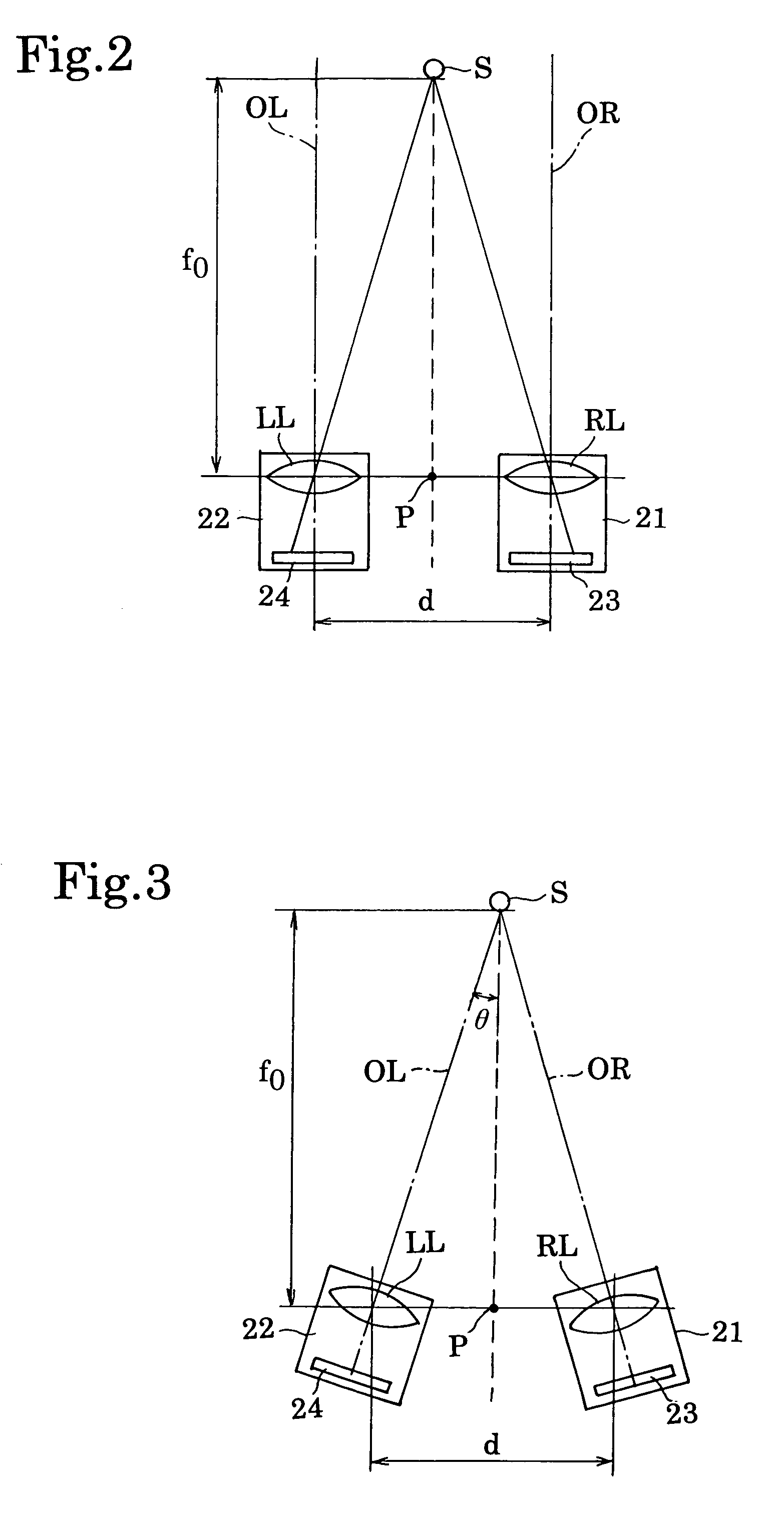Stereo camera
a camera and stereo technology, applied in the field of stereo cameras, can solve the problems of troublesome manual operation of adjusting the angle of convergence, and the difficulty of obtaining a three-dimensional photograph
- Summary
- Abstract
- Description
- Claims
- Application Information
AI Technical Summary
Benefits of technology
Problems solved by technology
Method used
Image
Examples
first embodiment
[0036]Embodiments of the present invention will be discussed below with reference to the drawings. FIG. 1 shows a stereo camera according to the present invention. The stereo camera 10 is an electronic still camera in which an object is photographed using an image pickup device and is comprised of a box-shaped housing 11 which is provided on the front portion thereof with a pair of right and left photographing optical systems RL and LL and on the rear portion thereof with a pair of right and left finder eyepiece portions RF and LF.
[0037]The housing 11 is provided on its upper surface with a function dial 12 which is adapted to turn the power source ON / OFF or select photographing modes, and a release button 13. A pair of operation buttons 14 and 15 are provided in the vicinity of the function dial 12 to select the frames or exposure correction value, etc. Also, an active type infrared object distance metering device 16 is provided on the front surface of the housing 11 and between th...
second embodiment
[0065]At step S118 in the second embodiment, the variable apex angle Φ is determined in accordance with the following expression (2):
Φ=(n−1)θ (2)
[0066]wherein “Φ” represents the variable apex angle (°) “n” represents the refractive index of the variable angle prisms RV and LV, and “θ” represents half of the convergence angle (deflection angle) (°), respectively.
[0067]Table 2 below shows a relationship between the object distance fo and the variable apex angle Φ when the base length d is 65 mm and the refractive index n is 1.5, respectively, in the stereo camera 100 according to the second embodiment.
[0068]
TABLE 2fo (m)Φ (°)10.93120.46650.186100.093
[0069]FIG. 13 shows a third embodiment of a stereo camera according to the present invention. The stereo camera 200 is an electronic still camera similar to the stereo camera 10 in the first embodiment. The camera 200 includes a box-like housing 101 which is provided on the front surface thereof with a pair of right and left photographing...
third embodiment
[0075]At step S120 in the third embodiment, the amount of shift (displacement) is determined in accordance with the following expression (3);
y=f·tan ω (3)
tan ω=0.5d / (fo+f)
[0076]wherein “y” represents the amount of shift (displacement) (mm), “f” represents the focal length of the lens (mm), “ω” represents half of the convergence angle (°), and “d” represents the base length between the right and left photographing optical systems RL and LL, respectively.
[0077]Although the variable angle prisms RV and LV are provided on the object sides of the right and left photographing optical systems RL and LL in the second embodiment, the arrangement of the variable angle prisms is not limited thereto. Namely, the variable angle prisms can be located at any positions within the light paths of the right and left photographing optical systems RL and LL. For instance, the same technical effect can be expected from an alternative arrangement in which the variable angle prisms RV and LV are provided...
PUM
 Login to View More
Login to View More Abstract
Description
Claims
Application Information
 Login to View More
Login to View More - R&D
- Intellectual Property
- Life Sciences
- Materials
- Tech Scout
- Unparalleled Data Quality
- Higher Quality Content
- 60% Fewer Hallucinations
Browse by: Latest US Patents, China's latest patents, Technical Efficacy Thesaurus, Application Domain, Technology Topic, Popular Technical Reports.
© 2025 PatSnap. All rights reserved.Legal|Privacy policy|Modern Slavery Act Transparency Statement|Sitemap|About US| Contact US: help@patsnap.com



